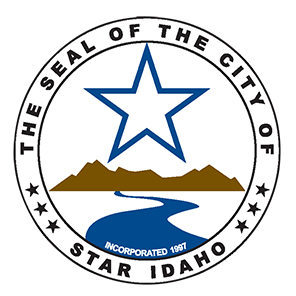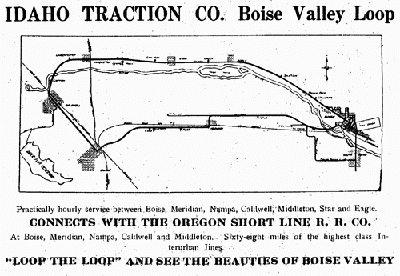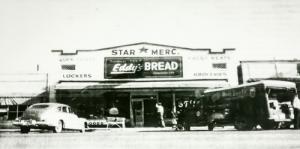History of Star
Early Settlement
The community of Star was one of the earliest settlements in the Boise Valley.
One of the first settlers was Ben F. Swalley who in 1863 drove his ox team and wagon onto 300 acres of land along the Boise River, one mile south of the present town. Others soon followed, homesteading the good farmland along the Boise River. The surrounding farms often catered to the needs of early travelers and miners providing them with food and lodging on their way to and from the mines in the Boise Basin.
One of the later branches of the Oregon Trail that crossed the river near Boise passed through what now is Star, just south of present-day Highway 44. Ezra Meeker, who spent his last years marking the course of the old Oregon Trail, visited Star on May 5, 1906. Portions of this early Oregon trail corridor became the Old Valley Road connecting Boise to Caldwell. In the spring, travelers had to take the alternate foothills road to keep from getting stuck in the mud bogs. Starting in the 1860s, the stage from Boise City followed Old Valley Road and arrived at Gray's Station just east of Star, near the old Balm Mill, on what is now Moon Valley Road. Here the stage left Old Valley Road and proceeded northwest through the sagebrush to the Willow Creek Stage Station, northwest of Star. The route continued to Payette and eventually to Umatilla, Oregon, and the Columbia River. Stage routes served the area through the 1880s with their big six-horse coaches.
The first location of the village of Star was one mile to the east of present Star, about halfway between the present town of Star and Star-Emmett junction. The first schoolhouse was built there in the 1870's on land donated by Ben F. Swalley. When the settlers finished building the schoolhouse, one of the men sawed out a star and nailed it to the front door, pounding nails all around its edge. This star became an important landmark for miles around and was a guide for travelers and miners. When they came to the schoolhouse with the star on the door, they would find lodging for the night. In time, the town became known as Star. The village of Star began to grow, providing services to travelers and serving as a rural center for neighboring farmers and ranchers. In 1880, a post office was established in Star with Shepp Gray the first postmaster and proprietor of the general store. The early settlement also had two blacksmith shops for "ironwork" as well as the district schoolhouse, two churches, and half a score of residences. The first hotel was opened in 1888.
The 1870s schoolhouse with the original star was eventually moved and later replaced by a brick schoolhouse on River Street in 1903. In 1912, Star had a new high school building. The 1870’s schoolhouse was dismantled in 1937 and a new school was built with the salvaged bricks. Star Elementary School was completed in 1975 adjacent to the brick schoolhouse which was later demolished. Star maintained its own school district for a period but is now part of the West Ada School District. A new middle school is opening in the fall of 2018.
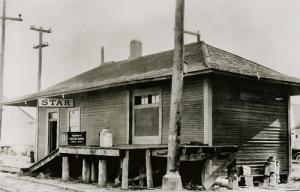
Star Incorporated
In 1905, Star incorporated and established city limits reaching four miles in all directions. During the early part of the century, the town grew rapidly. The town had a mayor, marshal, constable, and justice of the peace. The jail was a frame building located just east of the Odd Fellows Lodge Hall. By the time the new Interurban Railway arrived in 1907, at least twenty new buildings had been erected in Star. The Farmers Bank was charted in 1907, with Boise real estate developer, W.E. Pierce, as the bank's president. Other businesses included the Star Creamery, Conway Hotel, and El Dorado Lumber Company, which handled farm and orchard products. Star was a bustling village with a population of over 500 people, making it the second-largest community in Idaho after Boise. According to the 1907 Idaho Daily Statesman, "Business in all lines is well represented. There are five general merchandise stores, a drug store, one hardware, one lumber, and coal yard, carrying as complete a stock as is to be found in the state, two blacksmith shops, two first-class hotels, two livery stables, one real estate, and land office, newspaper and printing plant and the Farmers Bank of Star."
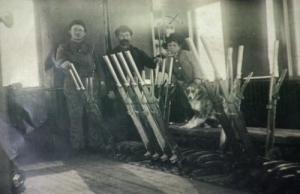
The Interurban Railway
In 1907, W.E. Pierce completed the electric railroad which ran from Boise to Caldwell, via Eagle, Star, and Middleton and circled back through Nampa and Meridian. Completion of the Boise Interurban brought electricity to Star created radical growth with W.E. Pierce and Co. platting two new areas of land to the east of the original townsite. These areas included Interurban Addition and the Pierce Addition. The Idaho Daily Statesman reported in 1907 that as a result of the completion of the Boise and Interurban line through Star, "citizens here have awakened to the fact that Star is very liable to become a very important point before long. There's been a great deal of building of late and the population of the town has easily doubled since it was definitely known that the electric line would be built through here." The Star Interurban Depot with a freight office and passenger waiting room was built at Valley and Knox streets in 1907. The building was designed by Boise architects Tourtellotte and Hummel. Nearby was the transformer house. With the introduction of automobiles into the Treasure Valley, the Interurban was used less and less, eventually going out of business in 1928. The loss of this link to the valley meant a decline in activity for Star. The depot was moved to the east side of town in the 1950s and is now occupied by Bobbie Jean’s coffee shop.
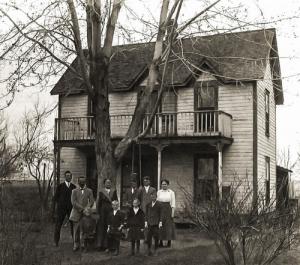
Business Activity
Growth continued in 1909 with at least 30 new buildings erected. That year the two-story brick Odd Fellows building was built, with part of the ground floor occupied by the Pinney Opera House. 1912 was another active building year, including the construction of the Friends Church and commercial buildings for J.W. Rounds, J.C. Hughes, and J B. Stoner. The Boise Payette Lumber Co. had a yard in Star starting in 1917. W.T. Kirtley erected the Star Mercantile Co. building in 1919. Over the years, the Star Mercantile made the transition from the cracker barrel store to a competitive mercantile carrying groceries, drugs, veterinarian supplies, stoves, and a complete line of appliances. Star also had a cheese factory in 1917, which later become the Mutual Creamery. The Star Courier provided weekly newspaper services from 1911 through 1920. The banner above the headlines read "News of Three Towns Covering North Side of the Boise Valley." These towns included Eagle, Star, and Middleton. Star reached its peak in the early 1920s with a population of over 600.
The Pioneer ditch was started in 1863 by M.B. Palmer and later extended to the Middleton Mill. This irrigation ditch and its supply of water allowed the country between Star and Middleton to be settled early.
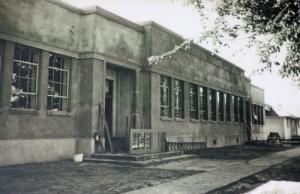
Decline & Re-Incorporation
Star's growth declined with the closure of the Boise & Interurban in 1928. In 1929 the state of Idaho paved the highway east and west of Star to the city limits. Star was expected to pay for the portion within the city limits. The local farmers balked at the idea of having their taxes raised to build the highway, so the city charter was turned back, and the highway became the property of the state and the town of Star was unincorporated.
On December 12, 1997, the Ada County Commission approved an order, proclamation, and resolution establishing the geographic boundaries of Ada county’s newest city. A mayor and six-member city council were also appointed, making the Star the first city to be incorporated in Ada County since 1971. Since then, the population remained around 500--about the same as it was early in the century. In recent years the population has grown exponentially both in Star and throughout the Treasure Valley.
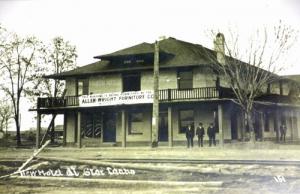
Agricultural Economy
The lowlands along the Boise River provide Star with a very flat topography allowing for numerous irrigation systems. Among these systems, the earliest to be installed was the Pioneer Canal, which dates from the 1860s. Others included the Lawrence Kennedy Canal on the south side of Star and the Middleton Canal to the north. The Canon Canal headgate is located on the Boise River just upstream from the Star Bridge. The Pioneer ditch was started in 1863 by M.B. Palmer and later extended to the Middleton Mill. This irrigation ditch and its supply of water allowed the country between Star and Middleton to be settled early. The area's surrounding farms have supported diversified farming, with the soil and climate being especially favorable for crops like alfalfa, sugar beets, and grains such as wheat and oats.
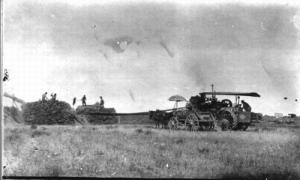
Events
In the early 1900s, Main Street periodically served as a race track. Horse races were a big event with almost everyone on hand and were often followed by a baseball game. Other activities included a Debating Society where issues of the day such as railroads, Sunday laws, and women's rights were discussed, a Literary Society, Star school sporting events, and a skating rink. An evening outing for a party of young people would often include chartering a trolley excursion to Boise. Star Trading Days were stock sales held every third Saturday of the month.
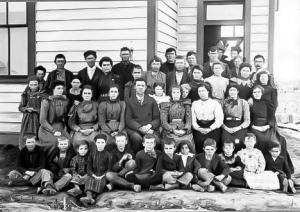
Star Cemetery
Gravestones of those who died along the Oregon Trail can be found in the Star Cemetery dating back to 1871. One marker is a hand-hewn stone, engraved with the name of Hester A. Riley, 1872. James and Jemima Ayers deeded the cemetery land to the community in 1900. The trustees were the Independent Order of Odd Fellows. In 1901, a picket fence was erected, encircling the cemetery.
Photos courtesy of Star Mercantile

